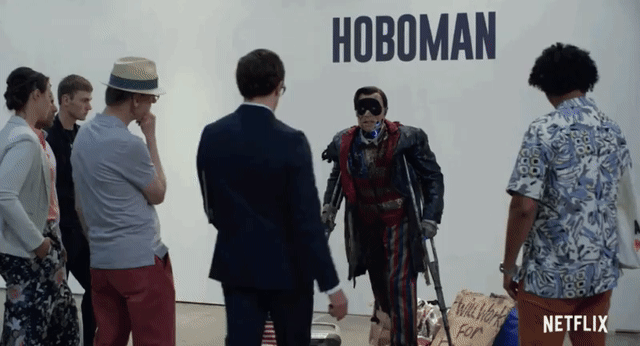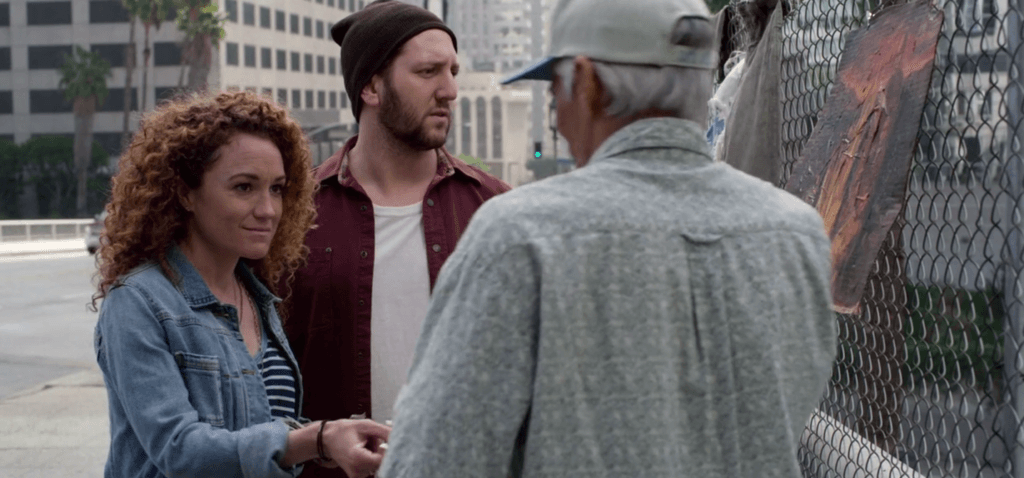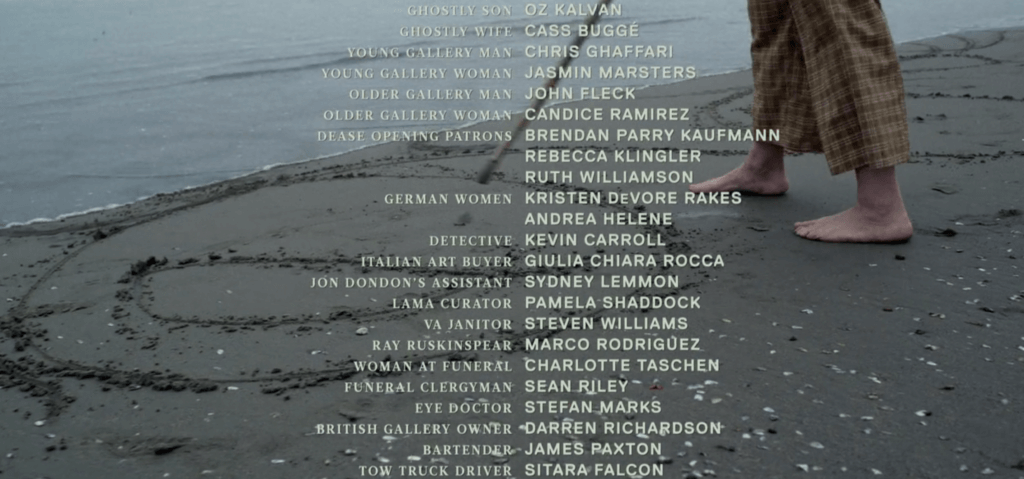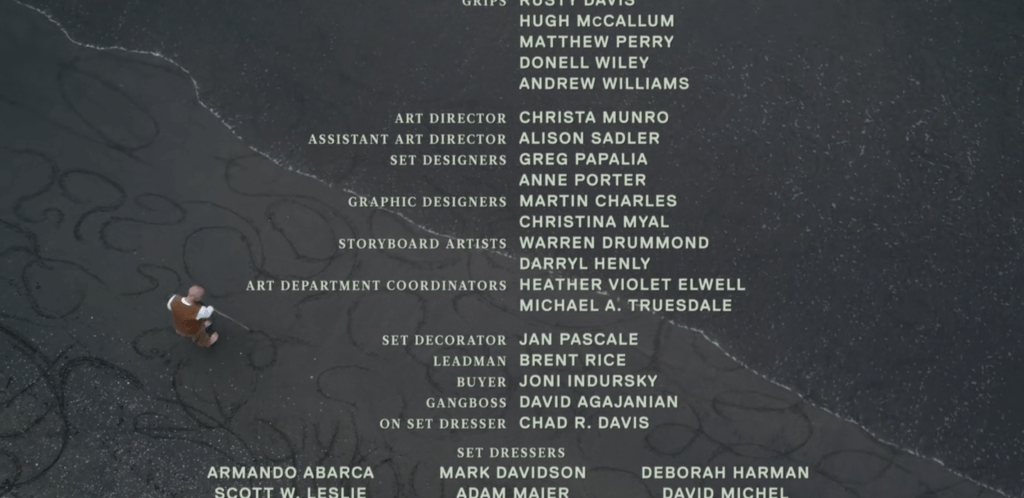In recent interviews Dan Gilroy (writer/director of Velvet Buzzsaw) has talked about two topics. His interest in the intersection between commerce and art. And one of his own Hollywood tragedies.
I went through a personal experience: I worked on the epic debacle Superman Lives. And I worked on it for a year and a half, and they finally pulled the plug on it two weeks before shooting. And I went down to Santa Monica, and I was sitting at the beach. For a year and a half, I’ve worked on this script. And I was watching the waves, and I thought: I could have written the words on the beach and have the water wash them away. And it was a real sobering thought. And shortly thereafter, I said to myself: It doesn’t matter. As a creator, it was a valuable experience. I got something out of it. I’ve grown as a writer. When I got up from the beach, I sort of decided that I was going to do things for myself as much as other people.
NPR
This is also the guy who ended his 2015 acceptance speech at the Independent Spirit Awards by saying: “Independent film, the foundation, and everybody here today, I think, are holdouts against the tsunami of superhero movies that have swept over this industry. We have survived and we have thrived. And I think that’s true spirit.”
This piece has two main parts. In the first, I’m going to pull back the curtain a bit on Velvet Buzzsaw, deconstructing and explaining what happened—the story, themes, ending. The second part is a bigger meta conversation about Gilroy’s reason for making Velvet Buzzsaw the way he did, especially as his follow-up to Nightcrawler.

What happened: story, themes, endings
Velvet Buzzsaw was essentially built on three desires:
- To show the superficiality of artistic gatekeepers
- To make a statement about the humanity of artistic creation vs. the dehumanization of art as commodity
- To make a schlock-y, trope-filled genre film
With those three desires in mind, what happens in the movie is, hopefully, pretty easy to understand.
You have an artist, Vetril Dease, who painted immensely alluring and foreboding works, based on his own painful, abuse-filled childhood. And madness—the guy was a nut. Clearly, Dease didn’t create out of a desire for fame or money. None of these paintings were released. And upon death they were to be destroyed.
We then have a few key figures who represent the upper echelon of artistic gatekeepers. Morf Vandewalt—the critic. Rhodora Haze, Josephine, Jon Dondon—the gallery owners. And Gretchen—the curator (who, by proxy, represents the wealthy). It’s the maneuverings of these characters that make up the bulk of the story. None of them are particularly likable, each of them does something shitty, and, surprise surprise, all five end up dead.

The three people who survive Dease’s supernatural killing spree are two artists and poor traumatized Coco (who finds the bodies of Dondon, Gretchen, and Morf). The first artist, Piers (John Malkovich), is someone who used to be great but became a commodity and lost his connection to his creativity. The second artist, Damrish (David Diggs), is young and full of talent and has taken the first step to becoming Piers. And Coco (Natalia Dyer) is a low-level, new-to-the-industry employee of Rhodora, then Jon Dondon, then Gretchen, then Morf.
Dease representing the purity of the artist—someone who creates out because they need to express their truth and life—puts into clearer context the morality and mentality of those two groups. Morf, Rhodora, Josephine Jon, and Gretchen all sought to profit from Dease. Whereas Piers and Damrish find the inspiration to become their best artistic-selves. Damrish rejects the commercial world; Piers reconnects with his ability to create for himself rather than others. And Coco? Coco is so traumatized by what happens to her employers that she leaves the industry before it claims her too.
As the point of Velvet Buzzsaw is to condemn the commodification of art and champion art we get two final scenes.
The sale and the sand
Early in Velvet Buzzsaw we see Bryson (Billy Magnussen), the handyman for the Haze Gallery, attempt to steal some crates of Dease paintings. He’s the film’s first casualty. The police or someone mention that they assume the homeless in the area had made off with any valuable items. This happens so early on that it might be surprising when, at the end of the movie, we see a homeless man with a makeshift sidewalk store hang up a Dease for sale.

Of course a curious couple stops. Like everyone else, they’re drawn to something in the art. They end up buying for $5 something the Haze Gallery would have sold for (I assume) millions. This plays into the idea that the value of art is subjective rather than objective. Graffiti done by Banksy isn’t inherently any more valuable than the graffiti of thousands of other talented artists…the only difference is critics and gallery owners and consultants and the wealthy have placed an immense price tag on Banksy. So everyone else does the same.
This gets into the concept of framing and anchoring.
If I show you a scuffed baseball and asked how much you think someone would pay for it, you probably wouldn’t guess a lot of money. But then I tell you two things. First, I tell you sports memorabilia is a thriving market (frame) with hundreds of millions (anchor) spent every year, with some items being valued at over one million dollars (anchor). Second, that the baseball in my hand was a home run hit by Babe Ruth in the 1932 World Series (frame). Now how much do you think someone would pay for it?
Much of Dan Gilroy’s complaint in Velvet Buzzsaw seems to be with the concept of how gatekeepers in the art world frame and anchor and thus determine the value of art and an artist. This point of view is contrasted nicely by the scene that follows the sidewalk purchase. Piers, another semi-forgotten aspect of the story, is on a beach. There, armed with a stick, he draws flourishing shapes in the sand. He’s absorbed by the work, riveted.

This version of Piers is a far cry from the man who had appeared earlier in the film. In his previous scenes, he talks about his struggles and inability to create anything meaningful. In fact, that’s what every character talks about when it comes to Piers. They just shit on him as being a has-been. The last conversation he has is with Rhodora is an in-road to understanding some of the thematic intent of Velvet Buzzsaw.
Piers reads out loud a piece of Paper handed to him by Rhodora (Rene Russo): “Dependency murders creativity. Creativity plays with the unknown. No strategies exist that can enclose the endless realm of the new. Only trust in yourself can carry you past your fears and the already known.”
Rhodora responds: “That’s Polly Anna*, 1983. I found it clearing out her apartment after she OD’d. I gave up being an artist a long time ago. But I know how this works. Forget about the art world. You need to get away from here, from all this, take a break. Use my beach house and stay there until you do something for nobody else but yourself.”
*[As far as I know, Polly Anna has no other mention in the movie. I think she was part of the Velvet Buzzsaw rock band that Rhodora had been part of. Maybe an ex of Piers as well?]

What we see Piers doing on the beach is him creating for himself and no one else. While we start zoomed in on the immediate movement of Piers and his stick, the camera eventually back ups to reveal the extent of his work. The swirls cover a relatively large space. It’s simple and beautiful. But also temporary, as the incoming tide washes away the lines. All the time and effort Piers has put in will be for nothing. Something that was there then wasn’t. But that’s kind of the point. Art doesn’t have the endure. It doesn’t have to profit. It can be temporary. It can be for no one but yourself. It can be worthless, and so becomes priceless. The artist can gain just from having had the experience.
Why it happened: Gilroy, art, commerce
Nightcrawler was Gilroy’s directorial debut, back in 2014. I honestly believe it’s an unheralded masterpiece. One of the top movies of not just 2014, not just the decade, but of the 21st century. The cinematography is gorgeous. The characters are dynamic. The performance by Gyllenhaal is incredible. It takes the basic feel-good underdog story that’s become an American fantasy/cliche and applies it to a psychopath’s journey to create a thriving small business of recording and selling violent footage to news stations. It’s the darkness of Taxi Driver meets the aspirational nature of The Pursuit of Happyness.
Nightcrawler is such a strong, prescient, and scathing critique and indictment of modern America economics, values, and spirit that it should be talked about all the fucking time. Instead, it’s a cult film. Lauded and beloved by a minority. Otherwise, rarely discussed. Almost as if it were also written in the sand.
If you compare Nightcrawler to Velvet Buzzsaw there’s a gigantic contrast in perceived quality. Nightcrawler is a clear display of artistic mastery, from the story to the themes to the visuals. Buzzsaw feels like…not that. A lot of the choices are cliche for the horror genre. If you’ve seen any single Final Destination movie then you pretty much know exactly how the story will play out. Story-wise, then, it’s a predictable movie.
Thematically, aside from the last scene with Piers, Gilroy conveys theme almost entirely through the most simplistic means a movie can: exposition-heavy dialogue.
And visually Buzzsaw is a safe movie, relying, as most genre films do, on a basic mix of character-focused medium close-ups (chest to top of the head) and close-ups (just the head/face). Most of the “artsy” films use the larger range of shots from extreme close up, close, medium close, full, long, medium long, and extreme long.
Typically, if you’re capable of the work Gilroy did on Nightcrawler then you continue to do that kind of work. Paul Thomas Anderson didn’t go from There Will Be Blood to Anchorman. He made The Master. Anderson’s idea of a more popular comedy was Inherent Vice, which is still heavy and artsy. So why would Gilroy change his approach so much, turning in a genre film that feels so contrary to the cinematic heights we know he’s capable of? When Scorsese did genre he made Shutter Island (which is consistently hailed for how it “elevated” genre tropes).
An easy answer would be, “Maybe Gilroy isn’t that good!” But, given what we know of the guy, I have a theory. I think he didn’t want to give “them” the satisfaction of cinematic art. He could have made another Nightcrawler quality work, a There Will Be Blood of the art industry. But then the very people he’s so displeased by would be glorified by the quality of the work. That’s a criticism of Scorsese’s Wolf of Wall Street. We’re supposed to be terrified of the Jordan Belforts of the world, but DiCaprio did such a great job as Belfort and Scorsese made such an incredible movie…we all kind of ended up admiring the movie version of Jordan Belfort. He and his life-style came off more attractive than disgusting.
So why would Gilroy do the same thing for critics and gallery owners and curators and the wealthy, the equivalent to Hollywood executive producers and studios and distributors who trample on artists like Gilroy? Instead, Gilroy opted for pop art, the kind of popcorn flick Hollywood has remade 1,000 different ways and releases every year because they know they’ll get a decent return on investment rather than if they took a risk on something deeper, grander, and more adventurous/dangerous.
If we believe this to be the case, it really raises the question of where do we find value in a movie? I may not think Velvet Buzzsaw was as enjoyable or interesting to watch as Nightcrawler or Final Destination or a Marvel movie. But if we look beyond what happened and into why it happened…Velvet Buzzsaw as a condemnation of the commerce of art as a whole…written and filmed in such a way to deny the commerce people the glorification of “cinema”…holy shit! That’s something that thrills me. He represents them in a far more cliche, mainstream style they would hate and condescend—which would, you can imagine, be a splinter in their psyche far sharper than mere condemnation or judgment of their character.
I think it would be easy to end on something catchy like, “Gilory’s ultimate point is it doesn’t really matter what I think.” But that seems too simplistic to me. It’s not that Gilroy denies art has value or conversation about art or art as something for others to engage with. He simply rejects the commercialism and politics that gets tied to the value of the art and the artist. I have to imagine Netflix was aware of (and thrilled by) this as well, as their whole approach is anti-box-office.
Anyway, with all that said, go watch Nightcrawler.


I’m fan of your reviews but here, specifically, to say thank you for making me to re-watch Nightcrawler. Really outstanding and out-of-the-box acting by JG. Such a character development! …. and beautifully mundane cinematography.
Really appreciate it! If you have any movies you’d like me to cover don’t hesitate to get in touch. Best, Chris